Hey everyone! My name is Brian McKay, and I’m the designer of Pocket Paragons. I’ve been working on this game since 2012, and it’s gone through a huge number of overhauls and redesigns in the last 9 years.
In this Pocket Paragons design blog, I wanted to show you the evolution of the game over those years and touch on a lot of the different versions and lessons learned from those scrapped ideas.
Countdown (2012)
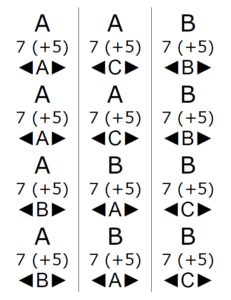
First build of Countdown, 2012. Rock/paper/scissors format for abilities that let you do bonus damage if your opponent played the matching letter.
The first iteration of the game was a game called Countdown, which was based on two design ideas:
1) Your deck was your health. Taking damage discarded cards from your deck, and you lost when you ran out.
2) Each turn you got a new hand, and you could draw as many cards as you’d like each turn.
The first idea was borrowed from the old pro wrestling card game Raw Deal. Using your deck as your health was a novel idea from that game, and although that game had a lot of other mistakes, it stood out to me. Drawing cards meant essentially taking damage, and combining that with the idea of “draw as much as you like” seemed like an interesting decision structure. You’d have more options, but at the cost of your health.
Countdown received some very harsh feedback in my first round of testing. It turns out, drawing lots of cards and having a ton of new options to consider every single turn was overwhelming, especially for a game that was supposed to be a simplified and cleaned-up version of another game. The criticism was definitely warranted in hindsight, but at the time, it was demoralizing, and I shelved the design entirely.
Reckoning (2014)
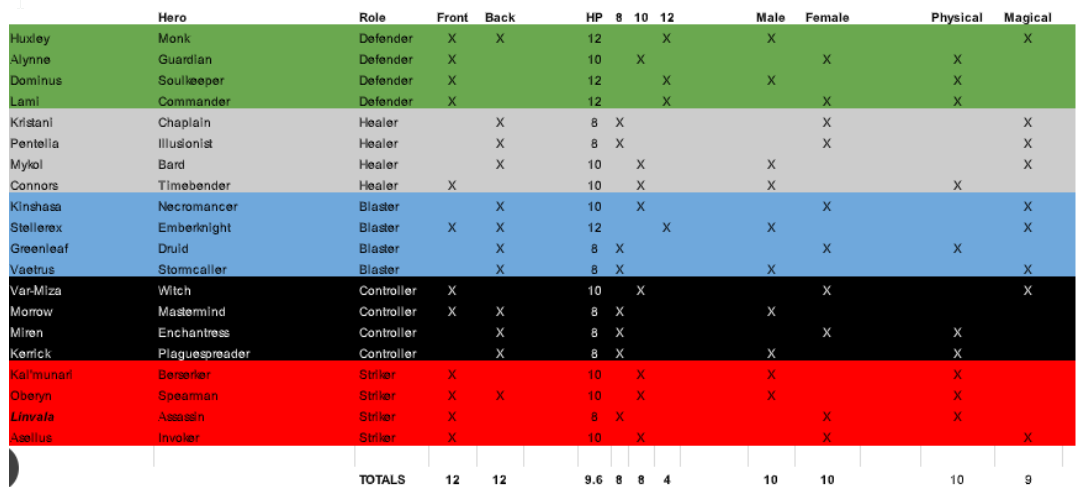
Early build of Reckoning, Oct 2014. The five roles were color-coded because I was making the prototypes in Magic Set Editor. I had a big emphasis on making sure the game was 50/50 gender split and tried to make sure the physical and magical characters were split along that line as well.
The mechanical part of Countdown I did like and wanted to keep wasn’t even one of the original two pillars of its design. Taking a look at your opponent’s options and trying to outmaneuver them was the successful part of Countdown, and the one I carried through to Reckoning.
Reckoning was heavily D&D-inspired. Many of the classes, and the Role system itself, were inspired directly from D&D’s 4th Edition. The HP values were all even numbers with the idea that you would track them with the D&D polyhedral dice.
In Reckoning, you would build a party of 4 heroes, having 2 in front and 2 in back. Each hero would contribute 2 ability cards to a shared deck of 8. Each player would play 2 of their abilities each round. Your played abilities would go on cooldown for one round, then you’d get them back at the end of the round
The cooldown system and a lot of the class concepts ended up (to some degree) in the final version, but the game got repetitive very quickly. The one-turn cooldown was added so you wouldn’t play the same abilities over and over, but with a one-turn delay, you were frequently just switching between your four best abilities constantly.
Rise of the Paragons (2015)
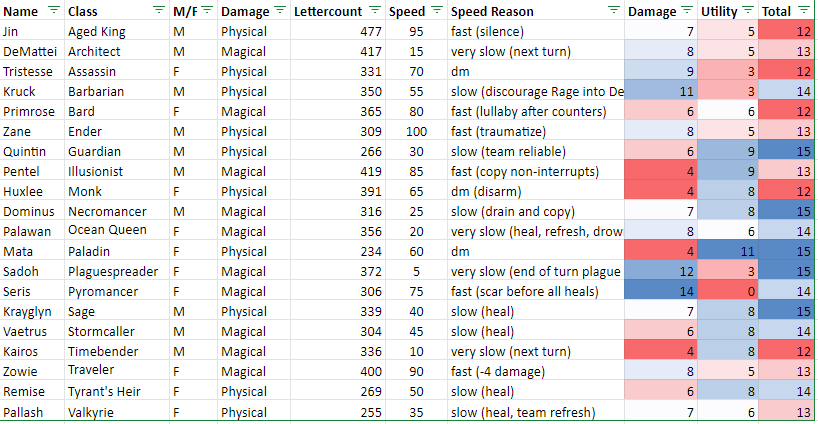
Early Rise design, March 2016. Characters had speeds to determine who would act first. Also running into space concerns on the cards, so I had to be mindful of my letter count for their abilities.
Rise of the Paragons cut the game down from 4 characters to 2, and then later back up to 3, but each character played 1 ability each round instead of just picking from a jumble. The key difference was that each ability went on cooldown until that hero played Rest. This was the saving grace of the game, and it was inspired by a mechanic I adored from the HeroClix miniatures game.
In HeroClix, after each miniature acted, it would receive an action marker to show that it moved. Next round, if that character acted again, they would overexert themselves, hurt themselves, and be forced to rest next turn. If they didn’t act, they removed their action counters. Choosing when to push your characters was a strong strategic choice, but getting to punish your opponent when you knew they had to do nothing was the exciting part for me.
Resting started off as just having to take a turn off as a drawback to get your abilities back, but a few of the characters had special abilities that would be more effective against resting opponents. These characters were consistently more fun and more powerful to the point where I realized it was so integral to the game that every character got a piece of the pie.
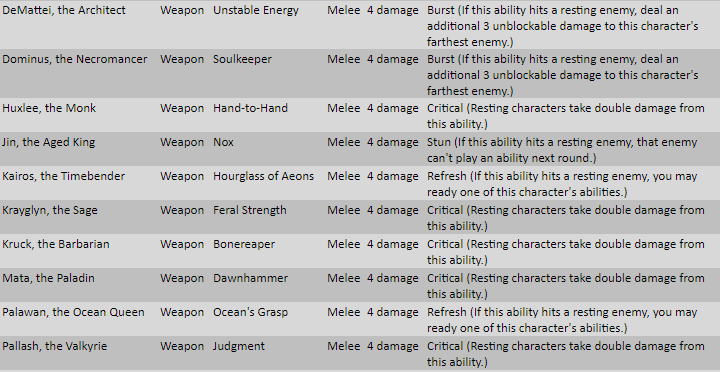
Every character gets a weapon, and all the weapons have names! Nov 2015.
Characters punished resting in different ways, but it quickly became clear that the Critical for double damage was not only the cleanest option but the most exciting, too. They eventually all became that.
Each character had their own deck of cards and you would choose a card for each character to play, but testing and feedback showed frustrations from the players that they didn’t know what the opposing cards could possibly do, and not having that knowledge in a game about predicting your opponent wasn’t working. To fix the issue, I made giant cards for each character with their abilities printed on them so they were clearly visible to both players. You would cover up the icons with bits when the abilities were used. I also borrowed a favorite mechanic from the X-Wing Miniatures game and used little dials to allow players to secretly choose their abilities for each character. A side benefit to these changes was that it made the game look incredible on the table with these giant pieces of art and secret dials.
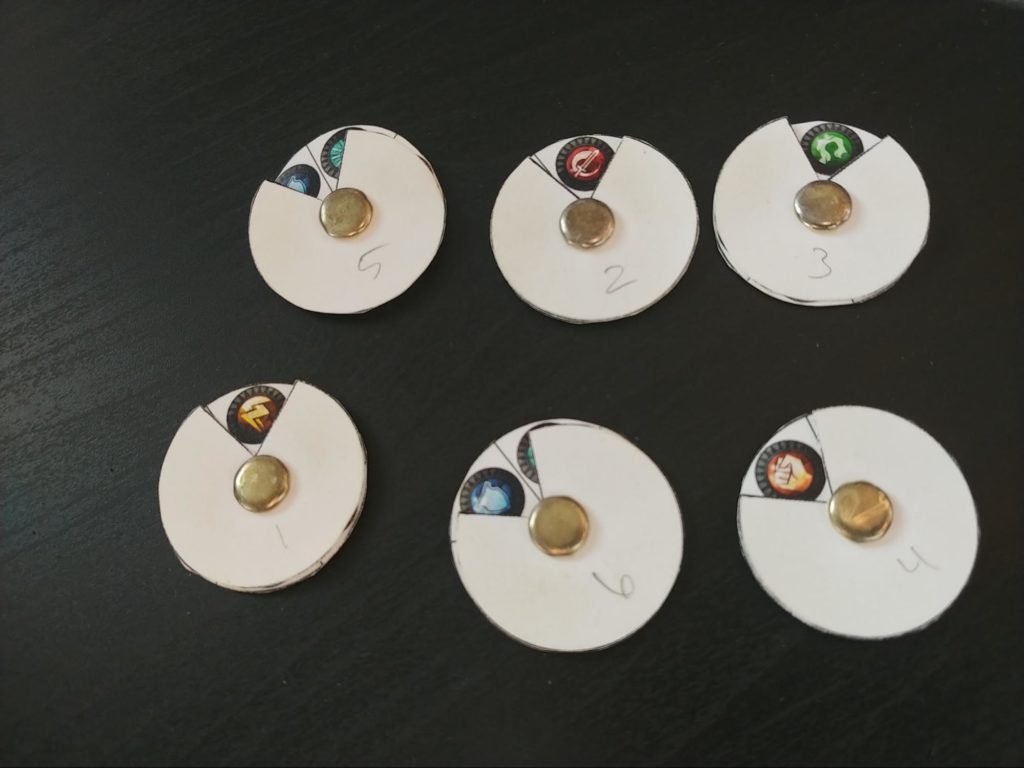
Top-quality dials made from cardstock and brass fasteners. This picture was taken in July 2020 because our head playtester Nick Rosener had held on to them for all these years.
A lot of the systems were working well, but having to manage 3 separate characters was complicated, and it took up a lot of table space. I cut it down to a 2v2, and that fixed a lot of the issues. But a recurring problem kept popping up that it was very strong to focus down one of your opponent’s two characters and leave them only playing one ability a turn to your two. Even if both your characters were low on HP, the 2v1 was impossible to come back from every time.
I tried a lot of different solutions, and the only one that led to good gameplay was letting the two characters share a health pool so that one couldn’t be knocked out without just losing the game. It played great, but thematically it just made no sense.
The game would undergo some radical changes! Join me next time for the second part of the Pocket Paragons design blog where I cover the future of the game. I’ll give you a hint: it involves giant robots!
-Brian Mckay